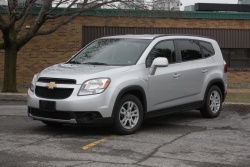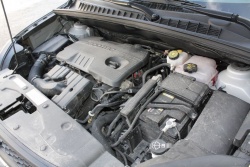 2012 Chevrolet Orlando LT. Click image to enlarge |
Review and photos by Chris Chase
Back to main review,
by Grant Yoxon
Photo Gallery:
2012 Chevrolet Orlando
The Chevrolet Orlando might be about as worldly as a car can get: this compact seven-seat MPV (multi-purpose vehicle) is a European model that’s manufactured in South Korea and named after a major U.S. tourist destination.
The irony of it all, though, is that despite bearing the badge of an American carmaker and the name of a place in that country, it isn’t sold there. Such are the differences between the Canadian and U.S. auto markets — and the similarities shared by Canada and other parts of the world — that we get the Orlando and Americans can’t have it.
Small, tall wagons like this are a big deal in Europe. They were a big deal here, too a number of years ago, before minivans, SUVs, and crossovers got big (figuratively). Then minivans, SUVs, and crossovers got big (literally) and created a niche market (again) for smaller vehicles like this Orlando and its key competitors, the Mazda5, Kia Rondo, and the forthcoming Ford C-Max.
 2012 Chevrolet Orlando LT. Click image to enlarge |
This is not the type of vehicle that sets hearts afire. However, we Canadians do like our practical vehicles, hence the Orlando’s availability here but not across the border.
All three Orlando trims (LS, LT and LTZ) use the same 2.4-litre, four-cylinder engine that makes 174 horsepower and 171 lb-ft of torque. LS and LT models come standard with a six-speed manual transmission that can be optioned to a six-speed automatic; the top-trim LTZ gets the automatic by default.
My tester was the same LT model with the automatic that Grant Yoxon drove. I’ve tested this powertrain before in the Buick Regal, and it’s just as boring in the Orlando as it was in that Buick, but it’s a better fit here, as the Orlando isn’t the car being marketed as a sport sedan. Still, it’d be nice if the engine and transmission behaved like moving a car around was something they wanted to do.
 2012 Chevrolet Orlando LT. Click image to enlarge |
The transmission is a lazy piece of work that’s reluctant to downshift at speed, and always feels like it’s second-guessing itself while shifting up through its six ratios during normal acceleration. Each shift is accompanied by a gentle lurch and just doesn’t feel very refined. That is, until you put your foot into it. Then the six-speed will happily bang off crisp, smooth, quick upshifts all day long. I haven’t driven an Orlando with the stickshift, but perhaps the few buyers who choose it will find it to be a better partner for this engine.
Grant says he found the Orlando provided “more than sufficient” acceleration, but I’d take out the “more than” qualifier and suggest the motor is strong enough, but only just. It has to work hard to get the Orlando up to speed; you can be in all the hurry you want, but the car won’t comply. Just as in the Regal, the 2.4L never sounds happy about being pushed hard. Granted, an MPV isn’t the type of vehicle that attracts hotshoe drivers, as evidenced by the even more leisurely Mazda5. (That car’s engine at least sounds happy enough to be worked hard.)











